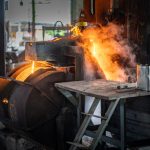 In the realm of metallurgy, the process of heat treating stands as a pivotal method for preserving the integrity of various metals. This crucial technique plays a fundamental role in maintaining and enhancing metal strength, durability, and resistance to wear. By subjecting metals to controlled heating and cooling cycles, manufacturers can achieve remarkable improvements in material properties, ensuring that metals not only withstand the test of time but also excel in demanding applications across diverse industries.
In the realm of metallurgy, the process of heat treating stands as a pivotal method for preserving the integrity of various metals. This crucial technique plays a fundamental role in maintaining and enhancing metal strength, durability, and resistance to wear. By subjecting metals to controlled heating and cooling cycles, manufacturers can achieve remarkable improvements in material properties, ensuring that metals not only withstand the test of time but also excel in demanding applications across diverse industries.
Understanding the Basics of Heat Treatment
At its core, heat treatment involves subjecting metals to specific temperature ranges, followed by controlled cooling processes. This intricate dance of heat application and subsequent cooling can induce profound changes in the microstructure of metals. One of the primary mechanisms at play is the alteration of crystal structures within the metal, influencing its mechanical properties.
Enhancing Metal Strength
One of the most significant benefits of heat treatment lies in its ability to enhance metal strength. By carefully manipulating the internal structure of metals, heat treatment can lead to improvements in hardness, tensile strength, and overall toughness. For instance, through processes like quenching and tempering, steel—a staple in various industries—can be fortified to withstand immense stress and pressure. This enhanced strength is particularly crucial in applications such as automotive manufacturing and aerospace, where materials must endure extreme conditions without compromising structural integrity.
Durability Beyond Ordinary Limits
Durability is a key concern across industries where metals are subjected to relentless wear and tear. Heat treatment acts as a guardian, reinforcing metals to endure harsh environments and prolonged use. For instance, in the production of cutting tools, where wear resistance is paramount, heat-treated metals exhibit a remarkable ability to maintain their sharpness and effectiveness over extended periods. This durability not only extends the lifespan of tools but also contributes to increased efficiency and cost-effectiveness in manufacturing processes.
Resisting Wear: A Shield Against Deterioration
Resistance to wear is a critical quality for metals employed in diverse applications, from industrial machinery to medical implants. Heat treatment can significantly bolster a metal’s ability to resist wear, ensuring that it remains functional even in abrasive environments. Consider the example of gears used in heavy machinery. Through carburizing—a specific heat treatment process—metals can acquire a hardened surface layer that resists abrasion, contributing to the longevity and reliability of the machinery.
Real-Life Examples: From Tools to Medical Devices
The impact of heat treatment reverberates across various sectors, influencing the performance of everyday objects. Think about the chef’s knife in your kitchen—a quintessential tool that undergoes heat treatment to ensure sharpness and longevity. Similarly, the medical field relies on heat-treated metals for implants and surgical instruments. The durability and corrosion resistance achieved through heat treatment are critical in ensuring the success of medical procedures and the longevity of implanted devices.
Aerospace Advancements: Where Every Gram Matters
In the aerospace industry, where every gram of weight carries significance, heat treatment plays a pivotal role. Aluminum alloys, extensively used in aircraft construction, undergo heat treatment to achieve the delicate balance of strength and weight. By carefully tailoring the heat treatment process, engineers can optimize the performance of materials, contributing to the overall efficiency and safety of aircraft.
Energy Sector: Heat Treatment in Harsh Environments
The energy sector, with its demanding conditions and extreme temperatures, relies on heat treatment to fortify materials used in exploration and production. Components subjected to high-pressure and high-temperature environments, such as drilling equipment, benefit from heat-treated alloys that can withstand the challenging conditions of deep-sea or underground operations. The resistance to corrosion and erosion achieved through heat treatment ensures the reliability and safety of critical equipment in the energy sector.
Summary
In the vast landscape of material science, heat treatment stands out as a guardian of metal integrity. Its influence extends far beyond the confines of a metallurgical laboratory, shaping the strength, durability, and wear resistance of metals in real-world applications. From the tools we use daily to the intricate components of aerospace and medical devices, the significance of heat treatment cannot be overstated. It is a testament to the marriage of science and industry, where controlled heat transforms raw metals into reliable, resilient materials that power the engines of progress across diverse sectors.
